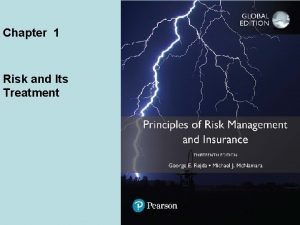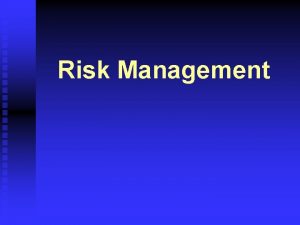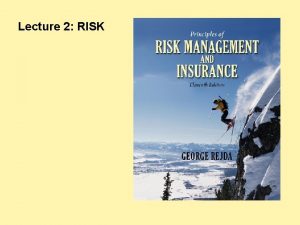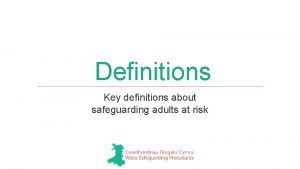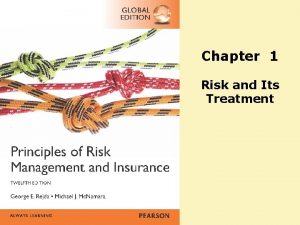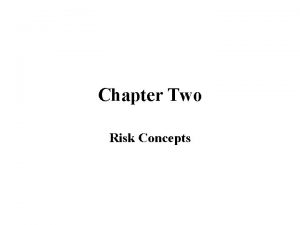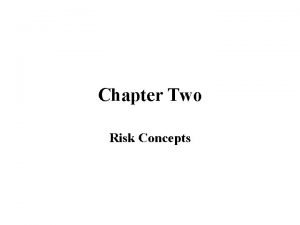Chapter 1 Risk and Its Treatment Agenda Definitions

























- Slides: 25

Chapter 1 Risk and Its Treatment

Agenda • • Definitions of Risk Chance of Loss Peril and Hazard Classification of Risk Major Personal Risks and Commercial Risks Burden of Risk on Society Techniques for Managing Risk

Definitions of Risk • Traditional Definition of Risk: Uncertainty concerning the occurrence of a loss • In the insurance industry, risk is also used to identify the property or life that is being considered for insurance • In economics and finance: – The term risk is used in situations where the probabilities of possible outcomes are known – Uncertainty is used in situations where such probabilities cannot be estimated

Definitions of Risk (Continued) Loss Exposure: Any situation or circumstance in which a loss is possible, regardless of whether a loss occurs Objective risk is defined as the relative variation of actual loss from expected loss It can be statistically calculated by some measure of dispersion, such as the standard deviation Subjective (perceived) risk is defined as uncertainty based on a person’s mental condition or state of mind

Chance of Loss • Chance of loss: The probability that an event will occur • Objective probability refers to the long-run relative frequency of an event based on the assumptions of an infinite number of observations and of no change in the underlying conditions • Subjective probability is the individual’s personal estimate of the chance of loss

Chance of Loss vs. Objective Risk • Chance of loss is the probability that an event that causes a loss will occur. • Objective risk is the relative variation of actual loss from expected loss The chance of loss may be identical for two different groups, but objective risk may be quite different! City # homes Average # fires Range Chance of Fire Objective Risk Philadelphia 10, 000 100 75 – 125 1% 25% Los Angeles 10, 000 100 90 - 110 1% 10%

Peril and Hazard • A peril is defined as the cause of the loss. – Examples include property damage because of fire, windstorm, or lightening, or damage to your car because of a collision with another vehicle. • A hazard is a condition that increases the chance of loss – A physical hazard is a physical condition that increases the frequency or severity of loss – Moral hazard is dishonesty or character defects in an individual that increase the frequency or severity of loss

Peril and Hazard (Continued) – Attitudinal Hazard (Morale Hazard) is carelessness or indifference to a loss, which increases the frequency or severity of a loss – Legal Hazard refers to characteristics of the legal system or regulatory environment that increase the frequency or severity of losses

Classification of Risk • Pure Risk and Speculative Risk – A pure risk is a situation in which there are only the possibilities of loss or no loss (earthquake) – A speculative risk is a situation in which either profit or loss is possible (gambling)

Classification of Risk (Continued) • Diversifiable Risk and Nondiversifiable Risk – A diversifiable risk affects only individuals or small groups (car theft). It can be reduced or eliminated by diversification. – A nondiversifiable risk affects the entire economy or large numbers of persons or groups within the economy (hurricane). It is also called fundamental risk. – Government assistance may be necessary to insure nondiversifiable risks.

Classification of Risk (Continued) • Enterprise risk encompasses all major risks faced by a business firm, which include: pure risk, speculative risk, strategic risk, operational risk, and financial risk – Strategic Risk refers to uncertainty regarding the firm’s financial goals and objectives. – Operational risk results from the firm’s business operations. – Financial Risk refers to the uncertainty of loss because of adverse changes in commodity prices, interest rates, foreign exchange rates, and the value of money.

Classification of Risk (Continued) • Enterprise Risk Management combines into a single unified treatment program all major risks faced by the firm: – Pure risk – Speculative risk – Strategic risk – Operational risk – Financial risk

Classification of Risk (Continued) • As long as all risks are not perfectly correlated, the firm can offset one risk against another, thus reducing the firm’s overall risk. • Treatment of financial risks requires the use of complex hedging techniques, financial derivatives, futures contracts and other financial instruments.

Classification of Risk (Continued) • Systemic risk is the risk of collapse of an entire system or entire market due to the failure of a single entity or group of entities that can result in the breakdown of the entire financial system • Systemic risk is especially important with respect to large financial institutions that are considered too large to fail without doing major financial harm to the US economy

Major Personal Risks • Personal risks are risks that directly affect an individual or family. They involve the possibility of a loss or reduction in income, extra expenses or depletion of financial assets, due to: – Premature death – Inadequate retirement income – Poor health – Unemployment

Exhibit 1. 1 Total Savings and Investments Reported by Retirees, Among Those Responding (not including value of primary residence or defined benefit plans)

Major Personal Risks (Continued) • Property risks involve the possibility of losses associated with the destruction or theft of property • Direct loss vs. indirect loss – A direct loss is a financial loss that results from the physical damage, destruction, or theft of the property, such as fire damage to a home – An indirect or consequential loss is a financial loss that results indirectly from the occurrence of a direct physical damage or theft loss (e. g. , the additional living expenses after a fire).

Major Personal Risks (Continued) • Liability risks involve the possibility of being held legally liable for bodily injury or property damage to someone else – There is no maximum upper limit with respect to the amount of the loss – A lien can be placed on your income and financial assets – Legal defense costs can be enormous

Major Commercial Risks • Firms face a variety of pure risks that can have serious financial consequences if a loss occurs: – Property risks, such as damage to buildings, furniture and office equipment – Liability risks, such as suits for defective products, pollution, and sexual harassment – Loss of business income, when the firm must shut down for some time after a physical damage loss – Cybersecurity and identity theft by thieves breaking into a firm’s computer system

Major Commercial Risks (Continued) • Other risks faced by business firms include: ‒ Human resources exposures, such as jobrelated injuries ‒ Foreign loss exposures, such as acts of terrorism ‒ Intangible property exposures, such as damage to the market reputation and public image of the company ‒ Government exposures, such as violation of safety standards

Burden of Risk on Society • The presence of risk results in three major burdens on society: – In the absence of insurance, individuals and business firms would have to maintain large emergency funds to pay for unexpected losses – The risk of a liability lawsuit may discourage innovation, depriving society of certain goods and services – Risk causes worry and fear

Techniques for Managing Risk • Risk Control refers to techniques that reduce the frequency or severity of losses: – Avoidance – Loss prevention refers to activities to reduce the frequency of losses • Loss reduction refers to activities to reduce the severity of losses: – Duplication – Separation – Diversification

Techniques for Managing Risk (Continued) • Risk Financing refers to techniques that provide for payment of losses after they occur: – Retention means that an individual or business firm retains part or all of the losses that can result from a given risk. – Active retention means that an individual is aware of the risk and deliberately plans to retain all or part of it – Passive retention means risks may be unknowingly retained because of ignorance, indifference, or laziness

Techniques for Managing Risk (Continued) • Self Insurance is a special form of planned retention by which part or all of a given loss exposure is retained by the firm • A Noninsurance transfers a risk to another party. – A transfer of risk by contract, such as through a hold-harmless clause in a contract – Hedging is a technique for transferring the risk of unfavorable price fluctuations to a speculator Incorporation of a business firm transfers to the creditors the risk of having insufficient assets

Techniques for Managing Risk (Continued) • For most people, insurance is the most practical method for handling major risks: – Risk transfer is used because a pure risk is transferred to the insurer. – The pooling technique is used to spread the losses of the few over the entire group – The risk may be reduced by application of the law of large numbers
 Chapter 1 risk and its treatment
Chapter 1 risk and its treatment Treatment plan goals for adhd
Treatment plan goals for adhd Market risk assessment
Market risk assessment Agenda sistemica y agenda institucional
Agenda sistemica y agenda institucional Emigree
Emigree Its halloween its halloween the moon is full and bright
Its halloween its halloween the moon is full and bright Residual risk and secondary risk pmp
Residual risk and secondary risk pmp Business risk vs financial risk capital structure
Business risk vs financial risk capital structure Attributable risk
Attributable risk Attributable risk formula
Attributable risk formula Parallelism for paired ideas
Parallelism for paired ideas Chapter 13 sentence check 2 answers curtail
Chapter 13 sentence check 2 answers curtail Chapter 28 oral diagnosis and treatment planning
Chapter 28 oral diagnosis and treatment planning Chapter 28 oral diagnosis and treatment planning
Chapter 28 oral diagnosis and treatment planning When a train increases its velocity its momentum
When a train increases its velocity its momentum Sunny windy cloudy rainy
Sunny windy cloudy rainy If its square its a sonnet
If its square its a sonnet Its not easy but its worth it
Its not easy but its worth it Risk projection attempts to rate each risk in two ways
Risk projection attempts to rate each risk in two ways Risk avoidance
Risk avoidance How to calculate relative risk
How to calculate relative risk Ar = ir x cr x dr
Ar = ir x cr x dr Absolute risk vs relative risk
Absolute risk vs relative risk Activity sheet 2 stock market calculations
Activity sheet 2 stock market calculations Risk classification
Risk classification Pembelanjaan risiko
Pembelanjaan risiko
